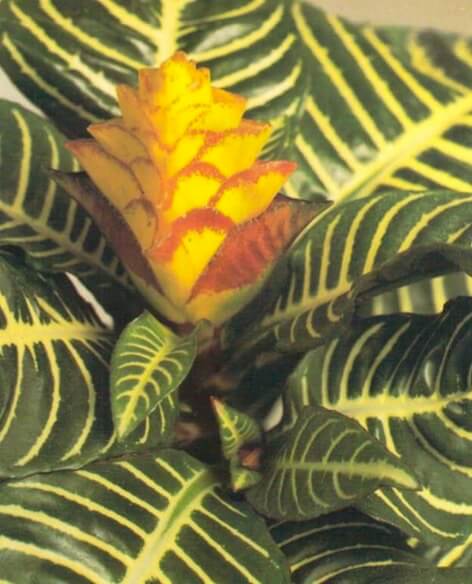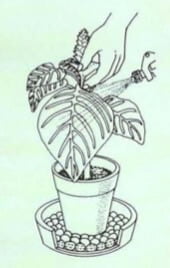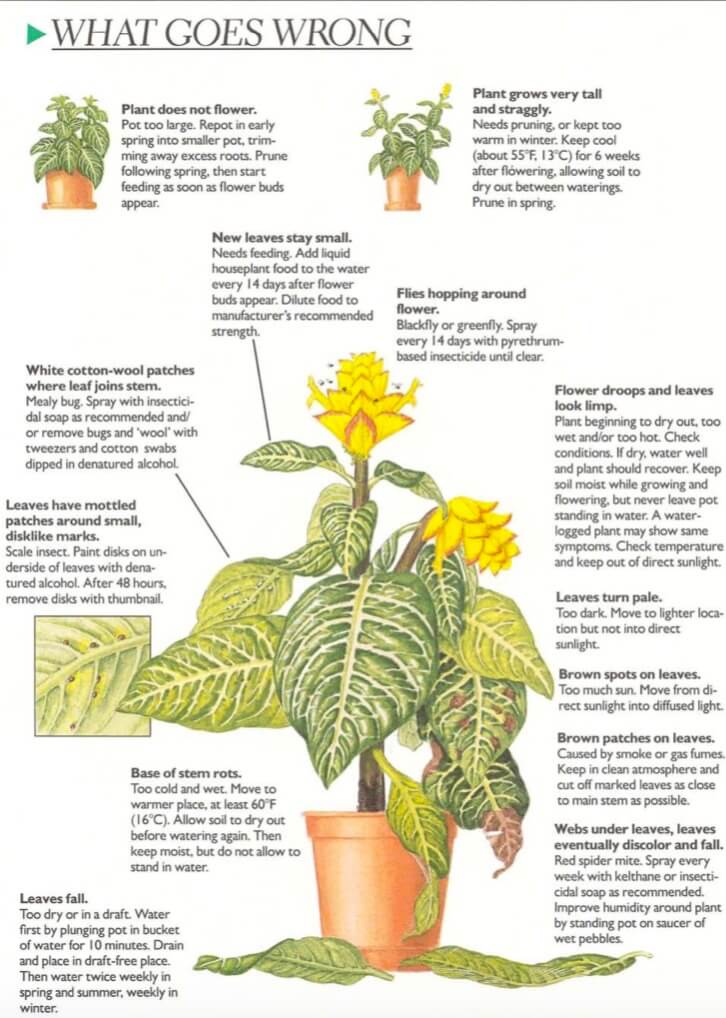[Ebook Việt Hoá] The Instant Guide to Healthy Houseplants (Hướng dẫn tức thời để chăm cây trong nhà khoẻ mạnh), Chi Aphelandra
[Ebook Việt Hoá] The Instant Guide to Healthy Houseplants: Aphelandra squarrosa (Zebra plant)
- Nguồn: [Ebook Việt Hoá] The Instant Guide to Healthy Houseplants (Hướng dẫn tức thời để chăm cây trong nhà khoẻ mạnh)
- Biên tập: Dũng Cá Xinh
- Biên dịch: Team Codai.net
English
This native of tropical and sub- tropical America produces bright yellow, pagoda-shaped flowers on the tips of its leaf stems. The striped foliage looks durable, but Aphelandras can be tricky to keep. They should never be allowed to dry out in the growing season. Once they have flowered, they should have a 6-week rest period, with watering cut down to once a week.

Light
Needs diffused daylight but no direct sunlight.
Temperature
Daytime maximum in summer, 80°F (27°C); nighttime, 65 of (18°C). When plant is resting after flowering, reduce day temperature to 65°F (18°C) and night temperature to 50- 55°F (10-13°C). Daytime minimum in winter, 60°F (16°C).
Water
At least twice a week in spring and summer, water to keep moist. When flowering has stopped, water only when soil surface feels dry; once a week should be sufficient. Plant must not shrivel.
Soil
Use equal parts loam and peat, along with one-eighth part sharp sand.
Humidity
Spray daily with soft water in growing season. Stand pot on saucer of pebbles almost covered with water. Reduce humidity when plant is resting or in low temperatures (below 55°F, 13°C).
Feeding
Every 14 days after first flower buds appear, feed with liquid houseplant food diluted according to manufacturer’s instructions. Do not feed in winter.
Repotting
In early spring after dormant period, repot plants more than 2 years old. Remove as much old soil as possible and use pot no larger than 5 inches (13 cm). Larger pots encourage straggly plants.
Cleaning
Spray with tepid water, avoiding flowers. If leaves are dusty, wipe with damp cloth. Use no leafshine.
Humidity
Spray every day in summer, once a week in winter. Protect flowers from spray. For extra humidity, stand the pot on a saucer of pebbles. Add water to almost cover the pebbles but do not let the base of the pot touch the water or the roots will become waterlogged.

What Goes Wrong

- Plant does not flower: Pot too large. Repot in early spring into smaller pot, trim- ming away excess roots. Prune following spring, then start feeding as soon as flower buds appear.
- White cotton-wool patches where leaf joins stem: Mealy bug. Spray with insecticidal soap as recommended and/ or remove bugs and ‘wool’ with tweezers and cotton swabs dipped in denatured alcohol.
- Leaves have mottled patches around small, disk like marks: Scale insect. Paint disks on underside of leaves with denatured alcohol. After 48 hours, remove disks with thumbnail.
- Base of stem rots: Too cold and wet. Move to warmer place, at least 60°F (16°C). Allow soil to dry out before watering again. Then keep moist, but do not allow to stand in water.
- Leaves turn pale: Too dark. Move to lighter location but not into direct sunlight.
- Leaves fall: Too dry or in a draft. Water first by plunging pot in bucket of water for 10 minutes. Drain and place in draft-free place. Then water twice weekly in spring and summer, weekly in winter.
- Brown patches on leaves: Caused by smoke or gas fumes. Keep in clean atmosphere and cut off marked leaves as close to main stem as possible.
- Webs under leaves, leaves eventually discolor and fall: Red spider mite. Spray every week with kelthane or insecticidal soap as recommended. Improve humidity around plant by standing pot on saucer of wet pebbles.
- New leaves stay small: Needs feeding. Add liquid houseplant food to the water every 14 days after flower buds appear. Dilute food to manufacturer’s recommended strength.
- Plant grows very tall and straggly: Needs pruning, or kept too warm in winter. Keep cool (about 55°F, 13°C) for 6 weeks after flowering, allowing soil to dry out between waterings. Prune in spring.
- Flies hopping around flower: Blackfly or greenfly. Spray every 14 days with pyrethrum- based insecticide until clear.
- Flower droops and leaves look limp: Plant beginning to dry out, too wet and/or too hot. Check conditions. If dry, water well and plant should recover. Keep soil moist while growing and flowering, but never leave pot standing in water. A water- logged plant may show same symptoms. Check temperature and keep out of direct sunlight.
Tiếng Việt
Loài cây có nguồn gốc từ vùng nhiệt đới và cận nhiệt đới Châu Mỹ này tạo ra những bông hoa màu vàng tươi có hình chùa ở đầu thân lá. Những tán lá sọc trông rất bền, nhưng cây Lá ngựa vằn khó giữ. Không bao giờ để cây bị khô trong mùa sinh trưởng. Khi đã ra hoa, chúng nên có khoảng thời gian nghỉ ngơi 6 tuần và giảm tưới nước xuống còn một lần một tuần.

Ánh sáng
Cần ánh sáng ban ngày khuếch tán nhưng không phải ánh nắng trực tiếp.
Nhiệt độ
Ban ngày tối đa vào mùa hè, 80 độ F (27 độ C); ban đêm, 65 độ F (18 độ C). Khi cây đang nghỉ ngơi sau khi ra hoa, giảm nhiệt độ ban ngày xuống 65 độ F (18 độ C) và nhiệt độ ban đêm xuống 50-55 độ F (10-13 độ C). Ban ngày tối thiểu vào mùa đông, 60 độ F (16 độ C).
Nước
Tưới nước ít nhất hai lần một tuần vào mùa xuân và mùa hè để giữ ẩm. Khi ngừng ra hoa, chỉ tưới nước khi thấy bề mặt đất khô; một lần một tuần là đủ. Cây sẽ không bị teo tóp.
Đất
Sử dụng hai phần đất mùn và than bùn bằng nhau, cùng với một phần tám cát sắc.
Độ ẩm
Phun hàng ngày bằng nước mềm vào mùa sinh trưởng. Đặt chậu trên đĩa sỏi gần như phủ đầy nước. Giảm độ ẩm khi cây đang nghỉ ngơi hoặc ở nhiệt độ thấp (dưới 55 độ F, 13 độ C).
Bón phân
Sau 14 ngày kể từ khi nụ hoa đầu tiên xuất hiện, sử dụng phân bón hữu cơ được pha loãng theo hướng dẫn của nhà sản xuất. Không bón phân vào mùa đông.
Thay chậu
Vào đầu mùa xuân, sau thời gian ngủ đông, thay chậu cho cây hơn 2 năm tuổi. Loại bỏ càng nhiều đất cũ càng tốt và sử dụng chậu không lớn hơn 5 inch (13 cm). Chậu lớn hơn cây sẽ mọc lệch.
Làm sạch
Phun bằng nước ấm, tránh hoa. Nếu lá bị bám bụi, hãy lau bằng khăn ẩm. Không sử dụng xịt bóng lá.
Độ ẩm
Phun hàng ngày vào mùa hè, mỗi tuần một lần vào mùa đông. Tránh phun nước vào hoa. Để có thêm độ ẩm, đặt chậu trên một đĩa sỏi. Cho nước vào ngập gần hết đá cuội nhưng không để đế chậu chạm nước nếu không rễ cây sẽ bị úng.

Các vấn đề có thể xảy ra

- Cây không ra hoa: Chậu quá lớn. Thay chậu nhỏ hơn vào đầu mùa xuân, cắt bỏ những rễ thừa. Cắt tỉa vào mùa xuân năm sau và bắt đầu bón phân ngay khi nụ hoa xuất hiện.
- Các mảng bông len màu trắng nơi lá nối với thân: Rệp sáp. Xịt xà phòng diệt côn trùng theo khuyến cáo hoặc loại bỏ các sợi bông len bằng nhíp và tăm bông nhúng vào cồn biến tính.
- Lá có những mảng lốm đốm nhỏ xung quanh: Sâu bọ. Phủ ở mặt dưới của lá bằng cồn biến tính. Sau 48 giờ, hãy lau các mảng đốm đi.
- Phần gốc bị thối: Quá lạnh và ẩm ướt. Di chuyển đến nơi ấm hơn, ít nhất là 60 độ F (16 độ C). Để đất khô trước khi tưới lại. Sau đó giữ ẩm, nhưng không để đọng trong nước.
- Lá nhợt nhạt: Quá tối. Di chuyển đến vị trí sáng hơn nhưng không tiếp xúc trực tiếp với ánh nắng mặt trời.
- Lá rụng: Quá khô. Tưới nước bằng cách nhúng chậu vào xô nước trong 10 phút. Để ráo nước và đặt ở nơi không có gió lùa. Sau đó tưới hai lần một tuần vào mùa xuân và mùa hè, hàng tuần vào mùa đông.
- Các mảng màu nâu trên lá: Do khói hoặc khí gas gây ra. Giữ trong môi trường sạch sẽ và cắt bỏ những lá có mảng nâu càng gần thân chính càng tốt.
- Mạng nhện dưới lá, sau đó lá phai màu và rụng: Nhện đỏ. Xịt hàng tuần bằng kelthane hoặc xà phòng diệt côn trùng theo khuyến cáo. Cải thiện độ ẩm xung quanh cây bằng cách đặt chậu trên đĩa sỏi ướt.
- Lá mới còn nhỏ: Cần nuôi dưỡng. Sử dụng phân bón hữu cơ pha loãng sau 14 ngày kể từ khi nụ hoa xuất hiện. Pha loãng phân bón đến độ đậm đặc của nhà sản xuất.
- Cây mọc rất cao và chênh vênh: Cần cắt tỉa hoặc giữ quá ấm vào mùa đông. Giữ mát (khoảng 55 độ F, 13 độ C) trong 6 tuần sau khi ra hoa, để đất khô giữa các lần tưới. Tỉa vào mùa xuân.
- Ruồi nhảy xung quanh hoa: Ruồi đen và ruồi xanh. Phun thuốc diệt côn trùng pyrethrum 14 ngày một lần cho đến khi khỏi bệnh.
- Hoa rũ xuống và lá trông mềm nhũn: Cây bắt đầu khô héo, quá ẩm ướt hoặc quá nóng. Kiểm tra các điều kiện. Nếu khô, tưới nước đầy đủ là cây sẽ phục hồi. Giữ ẩm cho đất khi cây phát triển và ra hoa, nhưng không bao giờ để chậu đọng trong nước. Cây ngập nước có thể có các triệu chứng tương tự. Kiểm tra nhiệt độ và tránh ánh nắng trực tiếp.
![[Ebook Việt Hoá] The Instant Guide to Healthy Houseplants: Aphelandra squarrosa (Zebra plant) [Ebook Việt Hoá] The Instant Guide to Healthy Houseplants: Aphelandra squarrosa (Zebra plant)](https://vn1.vdrive.vn/codai.net/2020/02/ebook-huong-dan-tuc-thoi-cham-cay-trong-nha-khoe-manh-29-aphelandra-squarrosa.jpg)


